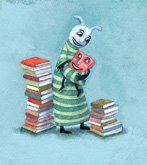This is a series of subtle interlocking novellas set in New York published over 85 and 86: City of Glass, "Ghosts" and "Locked Room with the first set in the period, the 2nd in the 40’s and the last one in the 70’s. They use mystery conventions of the gumshoe detective (think Humphrey Bogart) but in a subversive way as an existentialist reflection on writing, and story creation and communication but at the pace of a thriller; it more Kafka then Chandler with haunting imagery and surreal coincidences. But it also has deep emotional and psychological depths.
To give you a flavour of the book, in the City of Glass the main Character is Daniel Quinn a writer who has abandoned writing except for mystery writing owing to the death of his wife and child. He is successful enough to only need to write one novel a year which he has just done and then he drifts. He is clearly depressed and only feels alive when he is the private eye of his novels. One night he receives a midnight phone call asking for a detective called Paul Auster( yes the real author is also a later character in the story) and after several rejections he decides to act as if were his private eye character. His clients are a child-man who is a survivor of a dreadful abuse by his father (he was deprived of language as part of an experiment in discovering the natural language of man before the fall of the Tower of Babel) and his wife a nurse who had married him so that he could leave the hospital. The father now elderly is being released from Mental hospital and they fear that the son will be killed and want protection.
The story then takes many twists and turns and ends with the author as character being criticised by a final narrator who may be one of the characters from the other stories for what happens to Daniel Quinn during the course of the story.
In the Locked Room all the characters are named after colours and it’s a classical stake-out story but is it? Or is it a reflection on the lives of characters once that have been created and written about?
The final story is of two friends who have drifted apart, one wanted to be a writer and is now a critic unable to create works of his own imagination. He discovers that his friend has disappeared leaving a wife and baby and a locked room of manuscripts. These turn out to be masterpieces of novels, plays, and poems far beyond his capability of writing. In preparing those for publishing he re-enters and re-evaluates his life long friendship and what it meant but at a cost as he faces a secret that tests him and his relationships to destruction.
Paul Auster’s draws on his own colourful work life in his struggle to become a writer so the stories have a grain of gritty realism. But they are interlinked by an interest in the impact of coincidences and lives lived in minimalist even ascetic ways against a background of a loss, failure and absent fathers and reflections on writing and storytelling. If you want a painless way into postmodernist metafiction then this is the book for you. Highly recommended


No comments:
Post a Comment